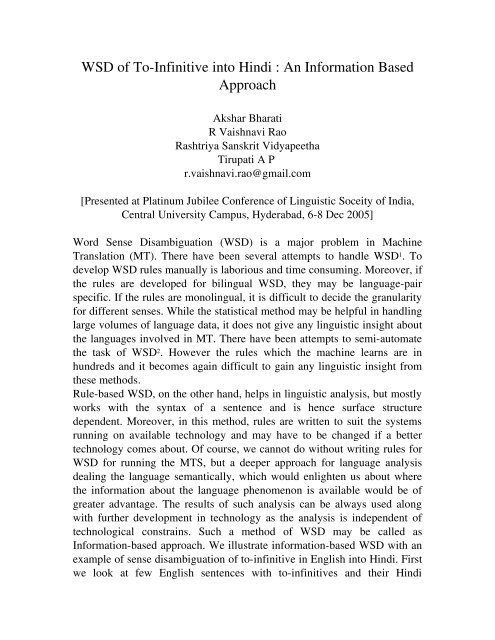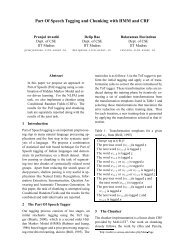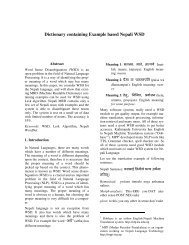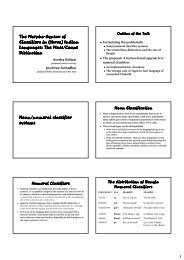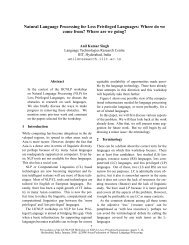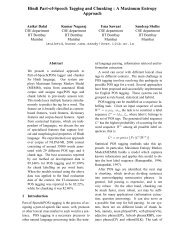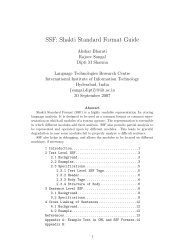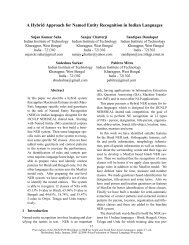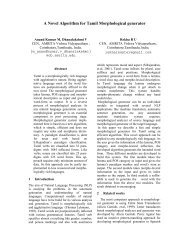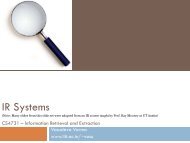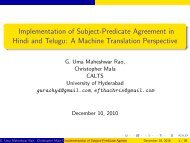WSD of ToInfinitive into Hindi : An Information Based Approach
WSD of ToInfinitive into Hindi : An Information Based Approach
WSD of ToInfinitive into Hindi : An Information Based Approach
You also want an ePaper? Increase the reach of your titles
YUMPU automatically turns print PDFs into web optimized ePapers that Google loves.
<strong>WSD</strong> <strong>of</strong> ToInfinitive <strong>into</strong> <strong>Hindi</strong> : <strong>An</strong> <strong>Information</strong> <strong>Based</strong><br />
<strong>Approach</strong><br />
Akshar Bharati<br />
R Vaishnavi Rao<br />
Rashtriya Sanskrit Vidyapeetha<br />
Tirupati A P<br />
r.vaishnavi.rao@gmail.com<br />
[Presented at Platinum Jubilee Conference <strong>of</strong> Linguistic Soceity <strong>of</strong> India,<br />
Central University Campus, Hyderabad, 68 Dec 2005]<br />
Word Sense Disambiguation (<strong>WSD</strong>) is a major problem in Machine<br />
Translation (MT). There have been several attempts to handle <strong>WSD</strong> 1 . To<br />
develop <strong>WSD</strong> rules manually is laborious and time consuming. Moreover, if<br />
the rules are developed for bilingual <strong>WSD</strong>, they may be languagepair<br />
specific. If the rules are monolingual, it is difficult to decide the granularity<br />
for different senses. While the statistical method may be helpful in handling<br />
large volumes <strong>of</strong> language data, it does not give any linguistic insight about<br />
the languages involved in MT. There have been attempts to semiautomate<br />
the task <strong>of</strong> <strong>WSD</strong> 2 . However the rules which the machine learns are in<br />
hundreds and it becomes again difficult to gain any linguistic insight from<br />
these methods.<br />
Rulebased <strong>WSD</strong>, on the other hand, helps in linguistic analysis, but mostly<br />
works with the syntax <strong>of</strong> a sentence and is hence surface structure<br />
dependent. Moreover, in this method, rules are written to suit the systems<br />
running on available technology and may have to be changed if a better<br />
technology comes about. Of course, we cannot do without writing rules for<br />
<strong>WSD</strong> for running the MTS, but a deeper approach for language analysis<br />
dealing the language semantically, which would enlighten us about where<br />
the information about the language phenomenon is available would be <strong>of</strong><br />
greater advantage. The results <strong>of</strong> such analysis can be always used along<br />
with further development in technology as the analysis is independent <strong>of</strong><br />
technological constrains. Such a method <strong>of</strong> <strong>WSD</strong> may be called as<br />
<strong>Information</strong>based approach. We illustrate informationbased <strong>WSD</strong> with an<br />
example <strong>of</strong> sense disambiguation <strong>of</strong> toinfinitive in English <strong>into</strong> <strong>Hindi</strong>. First<br />
we look at few English sentences with toinfinitives and their <strong>Hindi</strong>
translations. For example –<br />
E: I would love to live in New York.<br />
H: maiM New York meM rahanA pasaMda karUMgI.<br />
E: He tried to leave quietly.<br />
H: usane chupachApa j<strong>An</strong>e kA prayatna kiya.<br />
E: I am going there to see my sister.<br />
H: maiM apanI bahana ko dekhane ke liye vahA.N jA rahI hU.N. E: She<br />
refused to accept that there was a problem.<br />
H: usane m<strong>An</strong>ane se inakAra kara diyA ki koI samasyA thI.<br />
E: She is the next person to speak.<br />
H: vaha hai agali bolane vAlI vyakti.<br />
From the above illustrations we can see that toinfinitive has more than one<br />
mapping in <strong>Hindi</strong>. English has a single infinitive marker 'to' whereas <strong>Hindi</strong><br />
requires a marker 'nA' optionally followed by nominal suffixes (vibhaktis)<br />
such as kA, ke_liye, se, vAlI, etc. The kAraka relation <strong>of</strong> the toinfinitive<br />
with the other words in the sentence is not explicitly known from the<br />
surface <strong>of</strong> the sentence in which the toinfinitive is used. However, <strong>Hindi</strong><br />
requires an explicit vibhakti to specify the kAraka relation <strong>of</strong> the infinitive<br />
with the other words in the sentence. Realisation <strong>of</strong> this fact that English<br />
does not code something which <strong>Hindi</strong> requires explicitly is an important<br />
step in informationbased approach. So as a first cut, we may say that toinfinitive<br />
can be translated <strong>into</strong> <strong>Hindi</strong> as 'nA *' where '*' stands for the<br />
parasargas (postpositions) such as '0', 'kA', 'ke liye' etc. Thus, English is<br />
leaving something unspecified and <strong>Hindi</strong> obligatorily requires the<br />
unspecified information for the sentence to be grammatical.<br />
From this information we would first try to abstract what is common among<br />
the disparities and heuristically make a rule for MT. In this case we have<br />
fixed that toinfinitive may be translated, giving room for a few exceptions,<br />
as 'nA*'. This information may be used further for making rules for <strong>WSD</strong><br />
and where disambiguation becomes too obscure, this minimal information<br />
may give a broad hint about the sense <strong>of</strong> toinfinitive in the English<br />
sentence, which the user may be able to interpret from the expectancy<br />
(AkA.NkshhA) etc., context, world knowledge and so on. With this<br />
information we can make rules for <strong>WSD</strong> <strong>of</strong> the toinfinitive for humans by<br />
further semantic analysis, if not for machines immediately. This information<br />
may pay us in the long run; as and when we get more data in this regard; as<br />
and when technology would support us to use such rules <strong>of</strong> <strong>WSD</strong>. While<br />
trying to make rules <strong>of</strong> <strong>WSD</strong> for humans from the available information, the
question is, is it possible to "guess" the unspecified information just from<br />
the language strings? It is here that the Paninian model gives us insight<br />
about how to frame the rules for a language phenomenon keeping in mind<br />
both its syntactic and semantic considerations. Panini has explicitly<br />
specified the semantics <strong>of</strong> infinitives in his monumental work<br />
ashhTAdhyAyI 3 . We observe that some <strong>of</strong> the cases <strong>of</strong> the English toinfinitive<br />
may be translated as the affix 'tumun' in Sanskrit. Therefore we<br />
look at the rules dealing with tumun from ashhTAdhyAyI to gain further<br />
insight.<br />
There are five rules in the ashhTAdhyAyI stating the meaning <strong>of</strong> 'tumun'.<br />
They are as follows:<br />
1. tumuNNvulau kriyAyAM kriyArthAyAm [bhavishhyati kAle](3310).<br />
'tumun' and 'Nvul' are the affixes attached to the verb denoting an action<br />
which is to happen in the FUTURE and which is the PURPOSE <strong>of</strong> another<br />
action.<br />
S: kR^ishhNaM drashhTuM yAti.<br />
E: goes to see Krishna.<br />
2. sam<strong>An</strong>akartR^ikesshu tumun [ichchhArtheshhu](33158).<br />
'tumun' is affixed to the verb where the other verb denotes the action <strong>of</strong><br />
DESIRE and where the kartA (AGENT) IS SAME FOR BOTH ACTIONS.<br />
S: bhoktum ichchhati.<br />
E: wishes to eat.<br />
3.shakadhR^ishhaGYAglAghaTarabhalabhakramasahaarhaastiartheshhu<br />
tumun (3465).<br />
'tumun' is affixed to the verb in a sentence where the other verb is from the<br />
list <strong>of</strong> shaka etc. (This list is specific to Sanskrit language).<br />
S: bhoktuM shaknoti.<br />
E: can eat.<br />
4. paryAptivacaneshhu alamartheshhu [tumun](3466).<br />
'tumun' is affixed to the verb in a sentence where the related word is<br />
'paryApta' etc. that occur in the sense <strong>of</strong> CAPABILITY.<br />
S: bhoktuM paryAptaH.<br />
E: capable to eat.<br />
5. kAlasamayavelAsu tumun (33167).
'tumun' is affixed to the verb in a sentence where the related words such as<br />
kAla etc., referring to TIME, occur. Here the time to perform an action is<br />
indicated.<br />
S: bhoktuM kAlaH.<br />
E: time to eat.<br />
Here we see that except in rule 3, which only lists the verbs with which<br />
'tumun' can occur, all the rules describe the context and semantics <strong>of</strong> the<br />
affix 'tumun'. tumun' can occur as a modifier <strong>of</strong> a verb (as in 1 and 2), or<br />
forming a verb group (as in 3), or modifying a noun or an adjective (as in 4<br />
and 5).<br />
<strong>An</strong> attempt to write the rules <strong>of</strong> <strong>WSD</strong> <strong>of</strong> the toinfinitive <strong>into</strong> <strong>Hindi</strong> on the<br />
same lines actually throws light on the semantics <strong>of</strong> the toinfinitive, which<br />
is to be otherwise inferred from the context in which it is used. To put it<br />
explicitly, in the effort to get the information about the contexts in which<br />
<strong>Hindi</strong> takes a particular vibhakti for the otherwise inexpressive toinfinitive,<br />
we get to know as to what are the various meanings <strong>of</strong> the toinfinitive. The<br />
various senses <strong>of</strong> the toinfinitive can be broadly classified <strong>into</strong> the<br />
following categories –<br />
1. Toinfinitive semantically connected to another verb<br />
2. Toinfinitive semantically connected to a noun or an adjective,<br />
3. ECM constructions<br />
4. Toinfinitive forming part <strong>of</strong> a verbgroup, as in 'have to go'.<br />
5. Exception <strong>of</strong> translation <strong>of</strong> toinfinitive <strong>into</strong> nA*<br />
Let us discuss the <strong>WSD</strong> <strong>of</strong> the toinfinitive based on the above<br />
classification. 1. Toinfinitive semantically connected to another verb –<br />
a. Toinfinitive denoting the purpose as in<br />
E: I am going there to see my sister.<br />
H: maiM apanI bahana ko dekhane ke liye vahA.N jA rahI hU.N.<br />
<strong>Hindi</strong> uses 'ke_liye' to indicate the purpose, and hence in such cases, toinfinitives<br />
is to be translated as 'nA~ke_liye'.<br />
b. Toinfinitive as a modifier <strong>of</strong> the main verb meaning 'desire' <br />
E: I would love to live in New York.<br />
H: maiM New York meM rahanA pasaMda karUMgI.
Here the object <strong>of</strong> the main verb 'love' is another action itself; in this case<br />
'living in New York'. Here, the nonfinite verb indicates only action<br />
(bhAva). <strong>Hindi</strong> uses 'nA' to indicate the bhAva and hence in such cases, toinfinitive<br />
is to be translated as 'nA'.<br />
c. Toinfinitive modifying the main verbs such as 'refuse', 'fear', 'loath' etc. <br />
E: She refused to accept that there was a problem.<br />
H: usane m<strong>An</strong>ane se inakAra kara diyA ki koI samasyA thI.<br />
We can notice that the parasarga 'se', which indicates paJNchamI vibhakti<br />
(ablative case) is occurring where the main verb has the sense <strong>of</strong><br />
disapproval to it. Two sUtras in ashhTAdhyAyi could explain this<br />
phenomenon. 'dhruvam apAye apAd<strong>An</strong>am (1424)' and 'apAd<strong>An</strong>e<br />
paJNchamI (2328)' explain that, that which is the source <strong>of</strong> separation is<br />
apAd<strong>An</strong>am; and apAd<strong>An</strong>am takes paJNchamI vibhakti. In the example,<br />
mental separation from the act <strong>of</strong> 'acceptance' is intended to be conveyed by<br />
the verb 'refuse', which makes the act <strong>of</strong> 'acceptance' the 'apAd<strong>An</strong>a'. Hence,<br />
it takes paJNchamI vibhakti. The phenomenon <strong>of</strong> mental separation is<br />
common to all the verbs indicating the sense <strong>of</strong> disapproval. Where the<br />
source <strong>of</strong> mental separation is another activity indicated by an infinitive, it<br />
takes paJNchamI vibhakti in <strong>Hindi</strong>.<br />
d. Toinfinitive related with verbs whose <strong>Hindi</strong> translations are<br />
'kriyAmUla'<br />
E: He tried to leave quietly.<br />
H: usane chupachApa j<strong>An</strong>e kA prayatna kiya.<br />
The verbs such as 'promise', 'try' etc. are translated <strong>into</strong> <strong>Hindi</strong> as 'vAdA<br />
karanA', 'prayatna karanA' etc. These verbs are technically called as<br />
'kriyAmUla' verbs which retain an element <strong>of</strong> nominal tendency. Here the<br />
infinitive is literally connected with the noun such as 'vAdA' etc. In <strong>Hindi</strong><br />
the relation between nouns is indicated by shhashhThI vibhakti with the<br />
parasarga 'k[AI]' as in 'rAma kA kalama'. Hence, it acquires shhashhThI<br />
vibhakti.<br />
2. Toverb semantically connected to a noun/adjective:<br />
a. Toinfinitive modifying the words indicating 'time' –
E: It is time to go home.<br />
H: yaha ghara j<strong>An</strong>e kA samaya hai.<br />
This instance is covered by the Paninian rule 'kAlasamayavelAsu tumun' (3<br />
3167). Here the infinitive describes the 'time' and literally acts as an<br />
adjective to it. In <strong>Hindi</strong> the relation between an adjective and its<br />
corresponding noun is indicated by shhashhThI vibhakti with the parasarga<br />
'k[AI]', as in case <strong>of</strong> 'safeda raMga kI chAdara'. Hence, the infinitive takes<br />
shhashhThI vibhakti here.<br />
b. Toinfinitive modifying the nouns such as 'ability', 'tendency',<br />
'opportunity' etc.<br />
E: I have a tendency to tease.<br />
H: mujhe chheDane kA svabhAva hai.<br />
The phenomenon explained in (2a) applies here also. This instance is<br />
covered by the Paninian rule 'paryAptivachaneshhu alamartheshhu tumun'<br />
(3466).<br />
c. toinfinitive related with adjectives such as 'afraid' etc. –<br />
E: I was afraid to go home.<br />
H: maiM ghara j<strong>An</strong>e se bhayabhIta thI.<br />
The same phenomenon mentioned in rule (1c) above applies here also.<br />
Here, however mental separation is not indicated by a verb with a sense <strong>of</strong><br />
disapproval, but by the adjective 'afraid'. Here one more sUtra, viz.,<br />
'bhItrArth<strong>An</strong>AM bhayahetuH [apAd<strong>An</strong>am](1425)' may be quoted in<br />
support <strong>of</strong> the occurrence <strong>of</strong> paJNchamI vibhakti. According to the sUtra<br />
the cause <strong>of</strong> fear is apAd<strong>An</strong>a in case <strong>of</strong> words used in the sense <strong>of</strong> 'fear'. In<br />
the example, the act <strong>of</strong> 'going' is the cause <strong>of</strong> fear indicated by the word<br />
'afraid'. Hence, it is the apAd<strong>An</strong>a and it takes paJNchami vibhakti.<br />
d. Toinfinitive modifying the nouns –<br />
E: She is the next person to speak.<br />
H: vaha hai agalI bolane vAlI vyakti.<br />
Here the infinitive actually modifies the noun, which is the agent <strong>of</strong> the<br />
action denoted by the nonfinite verb. This is indicated by the affix 'vAl[AI]'<br />
in <strong>Hindi</strong> as in case <strong>of</strong> 'j<strong>An</strong>evAlI gADI' etc.
e. Toinfinitive related with adjectives such as 'anxious' –<br />
E: I am anxious to know.<br />
H: maiM j<strong>An</strong>ane ke liye utsuka hU.N.<br />
Here the adjective 'anxious' has the expectancy 'for what' (tAdarthya). <strong>Hindi</strong><br />
takes the chaturthI vibhakti (with the parasarga as 'ke liye') for expressing<br />
‘tAdarthya’ as in the case <strong>of</strong> 'laDake ke liye miThAI'. Hence the infinitive<br />
takes 'nA~ke_liye' in this case.<br />
f. Toinfinitive related with the adjective modified by 'too' –<br />
E: It was too hot to go out.<br />
H: bAhara j<strong>An</strong>e ke liye kuchha zyAdA hI garmI thI.<br />
The same phenomenon as in (2e) applies here.<br />
g. Toinfinitive related with adjectives such as 'easy', 'good' etc. –<br />
E: The path was easy to follow.<br />
H: mArga anusaraNa karane meM As<strong>An</strong>a thA.<br />
Though the same phenomenon as in (2e) and (2f) are applicable here and<br />
hence the translation 'mArga anusaraNa karane ke liye As<strong>An</strong>a thA' would<br />
not be wrong, it is the idiosyncrasy <strong>of</strong> the <strong>Hindi</strong> language to use the<br />
parasarga 'meM' in case <strong>of</strong> adjectives such as 'As<strong>An</strong>a', 'achchhA' etc.<br />
3. ECM constructions –<br />
Certain verbs, such as 'want', exhibit a special behaviour in English.<br />
For example, in the sentence <br />
E: I want him to go.<br />
'He' which is in the subject position <strong>of</strong> the verb 'go' gets case assigned by<br />
the verb 'want'. Here the kartA <strong>of</strong> the verb 'want' is 'I' and the kartA <strong>of</strong> the<br />
verb 'go' is 'he'. However, in <strong>Hindi</strong>, as in Sanskrit, the verbs denoting desire<br />
share their agents with the infinitive. This poses a problem from translation<br />
point <strong>of</strong> view which is discussed elsewhere 4 . We can notice that English<br />
also allows sentences with the main verb denoting ‘desire’ sharing its agent<br />
with the infinitive, as in <br />
E: I want a pen to write.<br />
The translation for this follows from rule (1a) and hence the translation for<br />
this sentence would be <br />
H: maiM likhane ke liye kalama chAhatI hU.N.
whereas, the translation <strong>of</strong> the above sentence will be <br />
H: maiM usakA j<strong>An</strong>A chAhatI hU.N.<br />
Hence we can see clearly that the ambiguity is difficult to resolve in such<br />
cases and some amount <strong>of</strong> knowledge <strong>of</strong> context is required to disambiguate<br />
the senses <strong>of</strong> these sentences. Hence, it is left to the user to decide the sense<br />
<strong>of</strong> the sentence in such cases.<br />
4. Toinfinitive forming part <strong>of</strong> a verbgroup –<br />
These are to be treated case by case. <strong>Hindi</strong> equivalents <strong>of</strong> each <strong>of</strong> the tam<br />
groups e.g. have_to_0, ought_to_0, etc. need to be given separately.<br />
E: I have to go home.<br />
H: mujhe ghara j<strong>An</strong>A hai.<br />
E: That child ought to be in bed.<br />
H: usa bachche ko bistara meM honA chAhiye.<br />
5. Exception <strong>of</strong> translation <strong>of</strong> toinfinitive <strong>into</strong> nA * <br />
There are a few cases which are exceptions to the default rule that toinfinitive<br />
is 'nA *'.<br />
a. To infinitive related to adjectives such as 'glad', 'sorry' etc. –<br />
E: I am glad to hear that news.<br />
H: maiM vaha khabara sunakara khush huI.<br />
This is an exception to the default rule accepted by us that toinfinitive is to<br />
be translated as 'nA *' in <strong>Hindi</strong>. On observing the context in the example we<br />
can see that the act <strong>of</strong> being glad follows the act <strong>of</strong> hearing. The temporal<br />
precedence (pUrvakAlikatva) <strong>of</strong> the action denoted by the main verb in<br />
comparison with the action denoted by the infinitive is indicated by the<br />
verbal affix 'kara' in <strong>Hindi</strong>.<br />
b. Toinfinitive in case <strong>of</strong> raising phenomenon –<br />
In case <strong>of</strong> raising phenomenon, English uses 'to' to convert the sentence<br />
with finite verb <strong>into</strong> a clause as in –<br />
E: It seems that John has left.<br />
By dropping 'it' the sentence 'John has left' is converted to a clause as in –<br />
E: John seems to have left.<br />
<strong>Hindi</strong> translation <strong>of</strong> this sentence, close to the English structure would be –
H: jA.cna, aisA lagatA hai ki, chalA gayA hai.<br />
Here, as such 'to' does not have any sense <strong>of</strong> its own. The presence <strong>of</strong> 'to'<br />
after 'seem' type <strong>of</strong> words seems to trigger the commas. Further reference is<br />
available elsewhere 4 .<br />
Implementation and Results<br />
The above rules have been implemented in the current EH anusaaraka. 140<br />
sentences were chosen covering different phenomenon stated above.<br />
Following table shows the performance <strong>of</strong> the system.<br />
<br />
Translation <strong>of</strong> toinfinitive Total instances Correct <strong>WSD</strong> by system %<br />
ne<br />
ke liye 54 50 92.6<br />
nA 31 27 87.1<br />
ne kA 12 12 100<br />
ne kI 3 3 100<br />
ne se 3 3 100<br />
ne meM 5 4 80<br />
ne ke liye kuchha jZyAdA hI 3 3 100<br />
TAM 27 16 59.3<br />
Kara 2 2 100<br />
<br />
Total 140 120 85.7<br />
<br />
Further, another set <strong>of</strong> 35 randomly selected sentences with toinfinitive<br />
were tested, and 30 <strong>of</strong> them were found to be translated correctly.<br />
Conclusion<br />
In the process <strong>of</strong> <strong>WSD</strong> <strong>of</strong> toinfinitive <strong>into</strong> <strong>Hindi</strong> we can observe that the<br />
vibhaktis in <strong>Hindi</strong> make the semantics <strong>of</strong> the infinitive quite transparent and<br />
explicit which is otherwise implicit in case <strong>of</strong> English. This is an example to<br />
show how comparison <strong>of</strong> different language structures can enlighten us<br />
more about the semantics <strong>of</strong> the languages involved. We can also observe<br />
that Paninian grammar serves two purposes for language analysis.<br />
1. The Paninian model serves as an ideal with regard to comprehensive
presentation <strong>of</strong> systematically analysed semantic and syntactic data <strong>of</strong><br />
language and thereby acts as a good tool for <strong>Information</strong>based analysis <strong>of</strong><br />
language data.<br />
2. The Paninian grammar explains language phenomenon clearly, thereby<br />
acting as a tool for problem solving in language.<br />
From the machine point <strong>of</strong> view, while trying to lead rulebased <strong>WSD</strong> to<br />
utmost possible perfection, mainly in case <strong>of</strong> words with high magnitude <strong>of</strong><br />
ambiguity, we face a problem <strong>of</strong> managing and maintaining the rules. It<br />
becomes quite a complex exercise to modify any existing rule when its<br />
exception is found. With the informationbased approach we get a good<br />
orientation about dealing with the rules given even for machines as we have<br />
a strong foundation <strong>of</strong> justified and logical causes for deriving such rules.<br />
This makes even voluminous rules fairly manageable.<br />
Appendix<br />
Following are the rules for <strong>WSD</strong> <strong>of</strong> toinfinitive <strong>into</strong> <strong>Hindi</strong> for the EH<br />
anusAraka.<br />
S.No Condition <strong>Hindi</strong> meaning<br />
1. from_list(previous_root,subj_subj_raising_verb.dat) <br />
#John seems to have left.<br />
2. from_list(previous_verb,ecm_verb.dat) &&<br />
following_category=v><br />
{tam:nA}<br />
# I want him to pass the exam<br />
3. from_list(previous_root,begin_to.dat) &&<br />
following_category=v><br />
{tam:nA}<br />
# <strong>An</strong>ne began to cry.<br />
4. previous_word=going> {tam:ne}<br />
#He is going to start it.<br />
5. from_list(previous_root,ability_to.dat) &&<br />
following_category=v ><br />
{tam:ne~kI}<br />
#He has ability to cross the river.<br />
6. from_list(previous_verb,promise_to.dat) &&<br />
following_category=v > {tam:ne~kA}<br />
#They promised her to go there.
7. from_list(previous_root,fear_to.dat) &&<br />
following_category=v ><br />
{tam:ne~se}<br />
#They fear to go there.<br />
8. from_list(previous_word,afraid_se_to.dat) &&<br />
following_category=v ><br />
{tam:ne~se}<br />
#I was afraid to go home.<br />
9. from_list(previous_word,happy_kara_to.dat) &&<br />
following_category=v ><br />
{tam:0_kara}<br />
#We were glad to see him.<br />
10. default_sense && following_category=v> {tam:ne~ke_liye}<br />
References<br />
1. Thesis <strong>of</strong> David Mowatt: Semantics and Machine Translation: What<br />
types <strong>of</strong> Semantic <strong>Information</strong> are necessary for Lexical Disambiguation for<br />
Machine Translation?<br />
2. Kilgarriff Adam, Tugwell David: WASP Bench A Machine Translation<br />
Lexicographer's Workstation Supporting the State <strong>of</strong> the Art Lexical<br />
Disambiguation, Machine Translation Summit VII, Santiagode Compostela,<br />
September 2001.<br />
3. Panini, ashhTAdhyAyI.<br />
4. Bharati Akshar, Amba Kulkarni, English from <strong>Hindi</strong> Viewpoint, LSI<br />
Platinum Jubilee, Central University, Hyderabad 2005.<br />
Toinfinitive
nA *<br />
Exceptions<br />
0 kara<br />
ke liye<br />
others<br />
se<br />
k[AI]<br />
vAlA<br />
meM


